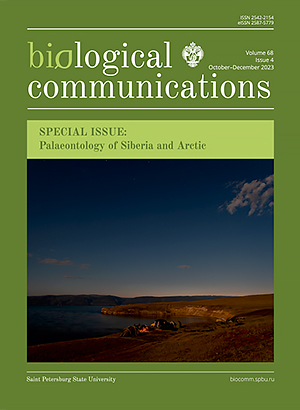A tiny duck (Sibirionetta formozovi sp. nov.), a giant grey partridge (Titanoperdix felixi gen. et sp. nov.), a new rail (Porzana payevskyi sp. nov.), and other birds from the Early Pleistocene of Baikalian Siberia
DOI:
https://doi.org/10.21638/spbu03.2023.406Abstract
The paper describes fossil birds from the Early Pleistocene (Gelasian) of Malye Goly locality in the Baikal area of the East Siberia (Irkutsk Region, Russia). This is the first studied bird fauna from the Early Pleistocene of the Northern Asia, shedding the first light on the early Quaternary bird associations of the Siberia. A tiny fossil duck Sibirionetta formozovi sp. nov. is the first fossil representative of the modern genus Sibirionetta, the modern endemic of Eastern Siberia. This find documents the long-time (at least since the Early Pleistocene) presence of these ducks in the region. A new large pheasant-sized phasianid bird Titanoperdix felixi gen. et sp. nov. is a large-sized representative of the grey partridge evolutionary lineage (Perdicini). This find is in agreement with the fact that modern relatively small grey partridges (genus Perdix) are phylogenetically nested within the larger-bodied pheasants. Among other birds from the locality are Tadorna tadorna, three other ducks (including one diving form), Perdix cf. dauurica, Porzana payevskyi sp. nov., Podicipedidae gen. indet., Scolopacidae gen. indet., and Corvidae gen. indet. The assemblage indicates a rather productive water body with mostly open landscapes in the vicinity. The avifauna from Malye Goly does not show any considerable affinity with the Late Pliocene avian assemblages from Southern Transbaikalia and Northern Mongolia, as well as with the Early Pleistocene bird fauna of Eastern China, and thus most likely represents a separate paleornithogeographical unit. Porzana payevskyi sp. nov. is one of the oldest confirmed representatives of Porzana s.s. in the fossil record, supporting the Asian origin of the genus and a probable out-of-Asia dispersal to North America in the Early Pleistocene.
Keywords:
fossil birds, early Quaternary, Eastern Siberia, North Asia, new taxa
Downloads
References
Downloads
Published
How to Cite
License
Articles of Biological Communications are open access distributed under the terms of the License Agreement with Saint Petersburg State University, which permits to the authors unrestricted distribution and self-archiving free of charge.





